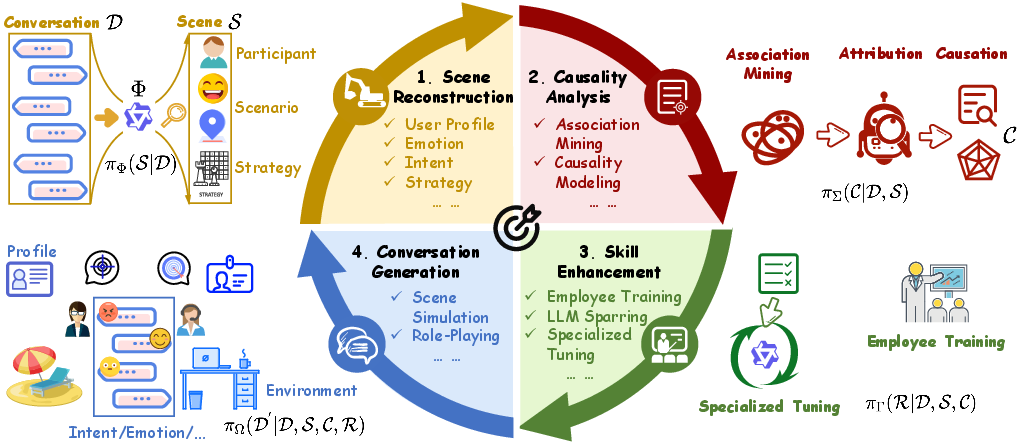- The paper demonstrates that LLM-driven conversation analysis enhances depth by employing a structured framework for scene reconstruction, causality, skill enhancement, and conversation generation.
- Methodologically, the survey outlines how LLMs bridge gaps in dataset scarcity and dialogue complexity to yield actionable business insights.
- The findings imply that future research should focus on robust benchmarks and LLM simulations to further optimize conversational interfaces.
The Imperative of Conversation Analysis in the Era of LLMs: A Survey of Tasks, Techniques, and Trends
Introduction
The paper addresses the growing importance of Conversation Analysis (CA) in the context of LLMs, highlighting the need to systematically extract and analyze critical information from conversational data. It emphasizes the transformative role of LLMs, which, unlike small LLMs (SLMs), possess world knowledge that enhances the depth and applicability of CA in real-world scenarios.
LLMs facilitate detailed, in-depth conversation analysis, moving beyond the shallow, fragmented results typically generated by SLMs. This advancement opens new avenues for deriving actionable business insights and optimizing language-based interfaces. However, challenges persist, including the lack of a comprehensive definition for CA, insufficient datasets, and the complexities inherent in modeling multi-turn dialogues and contextual dependencies.

Figure 1: Conversation analysis results are usually shallow in the era of small LLMs (SLMs) and cannot well empower the real-world applications, while LLMs possess world knowledge and can contribute to in-depth attributions and provide constructive insights or experiences.
Conversation Analysis Framework
The paper defines a structured framework for CA that encompasses four essential components:
- Scene Reconstruction: This involves inferential modeling to derive scene elements, such as participant profiles and emotional states, from conversational content.
- Causality Analysis: It focuses on uncovering the underlying factors leading to observed conversational elements and compiling comprehensive analytical reports.
- Skill Enhancement: This pertains to utilizing insights from CA to enhance human or AI capabilities, improving business outcomes through targeted training and optimization.
- Conversation Generation: Encompassing data collection and synthetic data generation, this process supports continuous iteration and refinement of conversational strategies towards achieving specific goals.
The integration of these components aims at goal-directed optimization, ultimately facilitating improvements in user experience and operational processes.

Figure 2: Overview of Conversation Analysis, which consists of 1) Scene Reconstruction, 2) Causality Analysis, 3) Skill Enhancement, and 4) Conversation Generation, centered around the goal-directed optimization.
Implementation Challenges and Future Directions
While the era of LLMs harbors significant potential for CA, several challenges remain:
- Data Scarcity: There is a dearth of datasets that adequately capture the intricate elements of conversational scenes, impacting the ability to model and evaluate CA effectively.
- Methodological Complexity: The inherent features of dialogues, such as multi-turn interactions and colloquial language, necessitate advanced modeling techniques beyond traditional approaches.
- Shallowness of Current Analysis: Existing methods often yield superficial results, lacking the depth required for meaningful business empowerment.
The paper suggests that future research should focus on developing robust benchmarks and designing evaluation protocols that align well with complex real-world goals. There is also a call for explorations into LLM-driven simulations and role-playing techniques that can enhance the realism and applicability of generated insights.
Conclusion
This paper lays the groundwork for a more integrated approach to CA by leveraging the capabilities of LLMs. By systematically defining the scope and components of CA, it sets the stage for developing tools and techniques that can deeply understand and predict conversational dynamics. The potential for CA to drive business innovation lies in overcoming current limitations and strategically utilizing the sophisticated understanding that LLMs provide. The outlined framework and identified challenges offer a path for future exploration and technical advancement in the field of conversational analysis.



